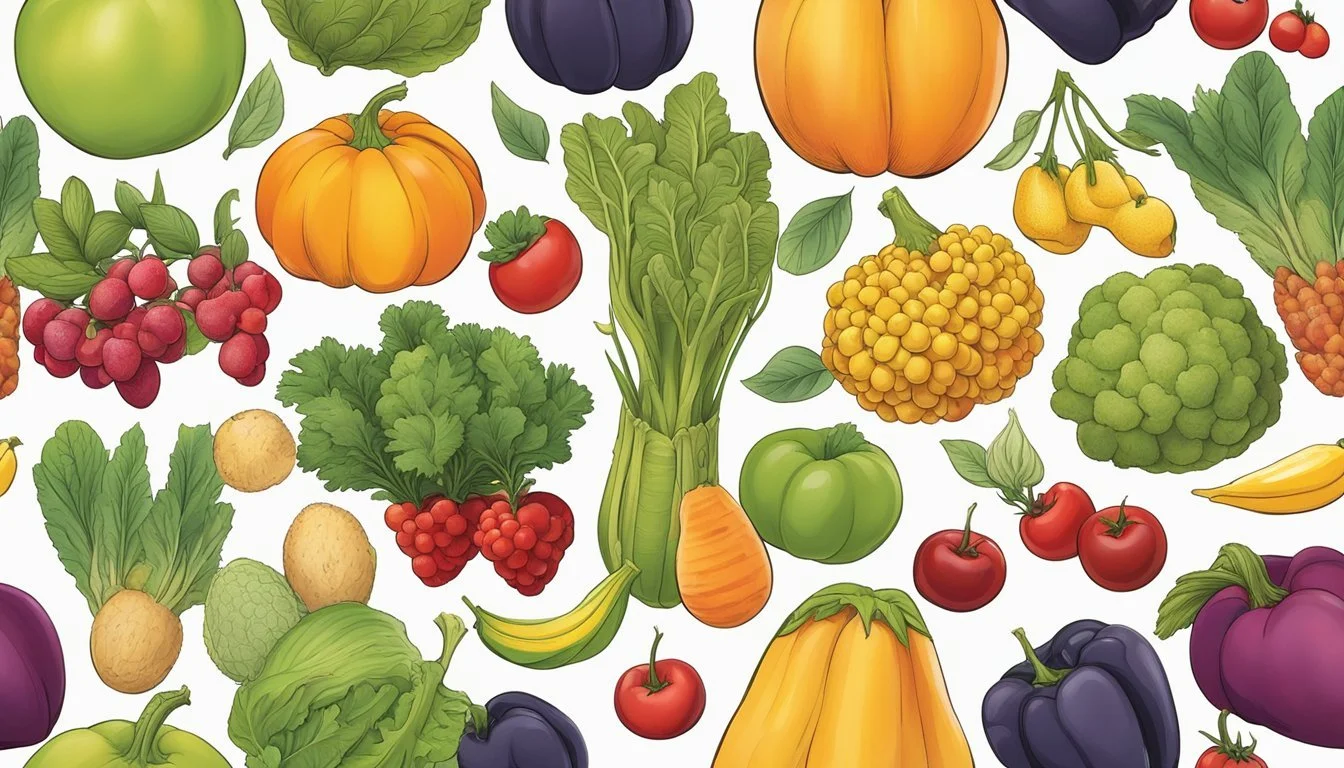Arizona Seasonal Fruit & Vegetables in March
Your Guide to Fresh Produce
This Article is Part of our Arizona Seasonal Fruit & Veg Calendar
Exploring Arizona's diverse agriculture reveals a rich tapestry of fruits and vegetables that vary with the seasons. March, a transitional time, offers a blend of winter's tail and the hint of spring's commencement. This month is notable for providing a variety of produce that is both ending its season and just beginning to flourish. Arizona's unique climate, which ranges from low desert to high country, creates distinct growing conditions that greatly influence the seasonal availability of its produce.
With the mild yet retreating chill of March, certain winter vegetables are still commonly available. Root vegetables like carrots (how long do carrots last?) and beets maintain their presence in the market, while the last of the winter greens such as kale and spinach make their final showing. Concurrently, the citrus season remains in full swing, bringing sweet and tangy flavors to the forefront with fruits like oranges and grapefruits.
The advent of spring also brings a new batch of produce to Arizona's farms. The warming temperatures usher in the early stages of crops like asparagus (What wine goes well with asparagus?) and artichokes (how long do artichokes last?), appealing to those eager for the first taste of spring's bounty. Moreover, the state’s myriad of microclimates allows for the successful cultivation of fruits and vegetables that would not typically be associated with a desert region, underscoring Arizona's unique agricultural landscape.
Overview of Arizona's Seasonal Produce
In March, Arizona transitions from the cool days of winter into the mild temperatures of spring, offering a unique array of fresh produce. Fruits like the vibrant clementines wrap up their season, delivering a final burst of citrus freshness, while vegetables remain abundant.
Vegetables flourishing in March include:
Broccoli: Appreciated for its nutritional benefits, broccoli thrives until March.
Brussels sprouts(how long do brussels sprouts last?): This flavorful veggie continues to be available during this month.
Cabbage: Various types of cabbage peak in freshness.
Carrots: Known for their versatility, carrots are harvested through May.
Celery: (how long does celery last?) Crunchy and hydrating, celery is in season.
Celery root: Also known as celeriac, a less common but flavorful vegetable.
One can find an overlap of winter robustness and the promise of spring in Arizona's March harvest. They can enjoy the last of the winter crops while the earliest spring varieties begin to emerge, exemplifying Arizona's diverse agricultural capabilities. The merging of seasons provides a blend of flavors and nutritional choices for consumers and showcases the state's rich agricultural tapestry.
Fruits Available in March
In Arizona, March is a prime month for enjoying a wide variety of ripe and sweet fruits. As trees and plants burst into life, the flavors of the season are predominantly citrus, but residents and visitors can also find bursts of sweetness from other seasonal fruits.
Citrus Fruits
March sees the peak of citrus season in Arizona. The fruits from citrus trees are not only ripe but also known for their vibrant flavor and sweetness.
Oranges: Oranges are at their juiciest, and varieties such as navel and Valencia can be found in abundance.
Tangerines: Smaller than oranges, these fruits are a favorite for their intense sweet flavor and easy-to-peel skin.
Grapefruits: The grapefruits of Arizona are known for a perfect balance of sweet and tart flavors.
Berries
While berries are not as dominant in March as citrus fruits, there is one variety that stands out during this month.
Strawberries: These berries start to come into season, offering their signature sweet and slightly tart flavor.
Other Seasonal Fruits
Apart from citrus and berries, other fruits also become ripe in March, although they are less prominent.
Dates: By March, dates that were harvested in the fall have often been dried and are ready to eat, sweet and chewy.
Vegetables Available in March
In Arizona, March brings an abundance of fresh vegetables to the table. With a range of vibrant colors and textures, these vegetables are at their peak, offering rich flavors and nutritional benefits.
Leafy Greens
Spinach: A versatile leafy green that is ideal for salads and cooked dishes.
Cabbage: It offers a crisp texture and is commonly used in slaws or fermented to make sauerkraut (how long does sauerkraut last?).
Root Vegetables
Carrots: Known for their sweetness when freshly harvested.
Potatoes: A staple root vegetable that is suitable for a wide variety of dishes.
Other Seasonal Vegetables
Asparagus: Tender and ripe, asparagus is a springtime favorite.
Broccoli: Packed with nutrients, vibrant green broccoli is ready to be enjoyed.
Cauliflower: Often found in shades of white and sometimes purple or green, adding visual interest to dishes.
Peas: Fresh peas can be shelled and added to a variety of recipes for a sweet, crisp element.
Health Benefits of Seasonal Produce
Consuming seasonal produce provides several health benefits. Fresh fruits and vegetables picked at their peak contain more nutrients than those harvested before they are ripe and then shipped long distances. The closer one eats produce after it has been harvested, the fewer nutrients it loses.
Raw, unprocessed fruits and vegetables retain the full spectrum of vitamins and minerals they contain. Seasonal produce often requires less transport and handling, which means it can be eaten closer to its natural state, maximizing its health potential.
Produce grown in season is more likely to be sourced from local organic farms. This not only supports local economies but can also be better for one's health. Organic farming typically limits or avoids the use of synthetic pesticides and fertilizers, reducing one's exposure to harmful substances.
Furthermore, the flavor of seasonal produce is often superior. Crops harvested during their appropriate seasons are naturally more flavorful, enhancing the enjoyment of meals and potentially encouraging a higher intake of healthy foods.
Below is a quick guide to the benefits:
Benefit Details Nutrient-rich Higher levels of vitamins and minerals due to minimal nutrient loss after harvest. Better taste Natural growing conditions enhance flavors, making them more palatable. Healthier options Organic, seasonal produce may contain fewer pesticides and promote cleaner eating. Environmental impact Reduced transportation leads to a lower carbon footprint.
One’s health can benefit significantly through the intentional inclusion of seasonal fruits and vegetables in their diet, as they are linked to a myriad of health benefits.
Recipes and Cooking Ideas
In March, Arizona's fresh produce offers vibrant flavors and textures ideal for crafting nutritious and delightful dishes. One can utilize fresh greens for salads, incorporate seasonal vegetables into hearty main dishes, and prepare light and flavorful sides.
Salads
Ingredient Highlights: Arugula (how long does arugula last?), Spinach
Citrus Arugula Salad: Toss peppery arugula with segments of grapefruit and oranges. Dress with a light vinaigrette and top with sliced almonds for a crunchy texture.
Spinach and Berry Salad: Dress fresh spinach leaves with a simple balsamic dressing. Add seasonal berries and toasted nuts (how long do nuts last?) to bring out the sweetness in this salad.
Main Dishes
Ingredient Highlights: Asparagus, Broccoli, Chicken
Grilled Chicken with Asparagus: Marinate chicken breasts in a lemon-herb mixture. Grill alongside fresh asparagus spears for a simple, flavorful dish.
Broccoli Chicken Stir-Fry: Stir-fry broccoli with pieces of chicken and a savory sauce. Serve over steamed rice for a complete meal.
Sides
Ingredient Highlights: Broccoli, Brussels Sprouts, Carrots
Steamed Carrot Medley: Steam young carrots with a touch of butter and fresh herbs. This method preserves their natural sweetness and texture.
Roasted Brussels Sprouts: Cut Brussels sprouts in half and toss with olive oil and sea salt (how long does sea salt last?). Roast until they're caramelized on the outside and tender within.
Growing and Harvesting Calendar
In March, Arizona's unique climate presents an array of growing and harvesting opportunities for gardeners and farmers. With the transition into early spring, the planting calendar fills with a variety of vegetables, fruits, and herbs suited to the regional conditions.
Planting Guide
Beginning in March, Arizona gardeners can start sowing seeds directly into their gardens or into containers. Phoenix and surrounding areas experience a moderate climate that allows for a diverse selection of crops to be planted.
Vegetables:
Leafy Greens: Lettuce, Spinach, Swiss Chard (30-60 days until harvest)
Root Vegetables: Carrots, Beets (50-75 days until harvest)
Legumes: Snap Beans, Lima Beans (how long do lima beans last?) (60-90 days until harvest)
Cucurbits: Summer Squash, Cucumbers (50-70 days until harvest)
Herbs:
Basil (60-75 days until harvest)
Cilantro (60-70 days until harvest)
These crops will thrive in the Arizona spring, germinating in the warming soils and longer daylight hours.
Harvesting Guide
For crops already in growth, March is the month where many will come to fruition. The harvesting window for these plants depends on the time of sowing and specific regional climate conditions.
Fruit Harvesting:
Citrus Fruits including Oranges and Grapefruits (Ready from winter into early spring)
Strawberries (if planted in fall or winter)
Vegetable Harvesting:
Cool-weather vegetables, such as Broccoli and Cauliflower, which were planted in late winter may be ready.
Leafy Greens like Lettuce and Spinach planted earlier may also be harvest-ready.
The calendar for March also suggests keeping an eye on soil temperature and regional weather forecasts to time the harvest for peak ripeness and flavor.
Where to Buy Local Produce
In Arizona, those seeking fresh, organic, and local produce have numerous options that support local farmers and the economy.
Farmers' Markets
Phoenix and surrounding areas in Arizona host a variety of farmers' markets where one can find a range of seasonal fruits and vegetables. Here are a few notable markets:
Uptown Farmers Market: Open year-round, offering a rich selection of locally-grown produce.
Roadrunner Park Farmers Market: A long-standing market with fresh Arizona-grown fare.
Grocery Stores
Local grocery stores frequently stock produce sourced from Arizona farms. It's beneficial for shoppers to inquire about the origin of the fruits and vegetables to ensure they're purchasing local goods.
Organic Sections: Look for designated organic sections that often contain local produce.
Local Produce Labels: Many stores use labels to identify local Arizona produce.
Organic Farms
Organic farms in Arizona often sell directly to the public and are an excellent source for fresh, organic produce. They may provide farm stands or participate in Community Supported Agriculture (CSA) programs:
Farm Stands: Farms like Maya's Farm in Phoenix offer a selection of organic produce right on the premises.
CSAs: By subscribing to a CSA, consumers can receive regular deliveries of fresh, seasonal produce from local Arizona farms.
Sustainability and Supporting Local Agriculture
Sustainable farming practices in Arizona are vital for maintaining the ecological balance and ensuring long-term agricultural productivity. Local farmers using these practices contribute significantly to the state's economy and environment. By purchasing fruits and vegetables from neighborhood farmers' markets, Arizonans support these efforts and promote a robust local farming sector.
Organic Produce: Organic produce is a cornerstone of sustainable agriculture. Farmers invest in natural growth techniques that forgo the use of harmful pesticides, which is better for the environment. Organically grown fruits and vegetables from Arizona's farms often make their way to consumers through farmers' markets and local food programs.
Benefits of Local Produce:
Freshness: Locally grown food is harvested at peak ripeness.
Nutrient Rich: Shorter time from farm to table ensures higher nutrient content.
Economy: Supports the local economy and creates jobs.
Local Farming efforts are seen in the wide variety of seasonal fruits and vegetables available, typically harvested between January and March. These offerings represent Arizona's commitment to sustainable growing methods, reducing the carbon footprint associated with long-haul transportation.
Seasonal Harvest in March may include:
Citrus fruits like Seville sour oranges
Leafy greens such as lettuce and spinach
Supporting local and sustainable Arizona agriculture is not just about making healthier choices but also about fostering community connectivity and preserving the environment for future generations. The readily available organic and seasonal produce at Arizona's farmers' markets reflects the state's dedication to these ideals.







